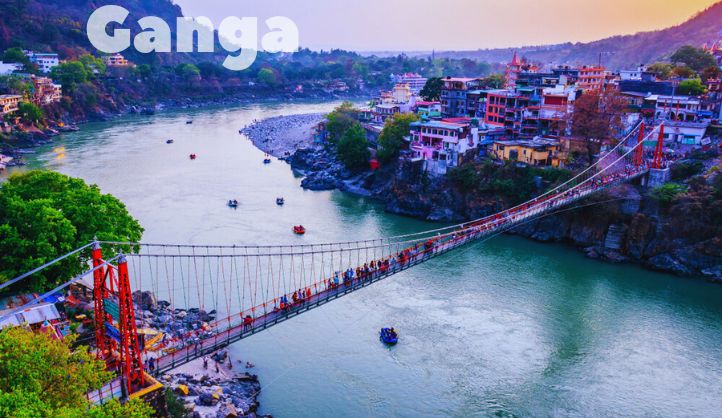Imagine a river so vast and sacred that it has been worshipped for millennia, its waters believed to purify the soul and nurture civilizations. Welcome to the story of the Ganga River, often referred to as the Ganges, the lifeblood of India. From its pristine origins in the Himalayas to its vast delta in the Bay of Bengal.
Origins and Course of the Ganga
The journey of the Ganga begins high in the Himalayas at the Gangotri Glacier, where it is known as the Bhagirathi. Legend has it that the river was brought to earth by the penance of King Bhagirath, who sought to purify the ashes of his ancestors. The river’s icy origins are a stark contrast to its warm, bustling life downstream.
The Confluence at Devprayag
As the Bhagirathi flows down, it meets the Alaknanda River at Devprayag, marking the official beginning of the Ganga. This confluence is one of the Panch Prayag, the five sacred river confluences in the Himalayas. It’s a sight to behold, where the waters blend and the journey of the Ganga truly begins.
Journey Through the Heartland
The Ganga flows through several states, including Uttarakhand, Uttar Pradesh, Bihar, and West Bengal. It passes through iconic cities such as Rishikesh, Haridwar, Varanasi, and Kolkata. Each city along its banks has its own story, traditions, and rituals centered around the river.
The Delta and the Bay of Bengal
As the Ganga approaches its journey’s end, it forms the Sundarbans Delta, one of the largest in the world. This delta, rich in biodiversity, is a UNESCO World Heritage Site and home to the famous Bengal tigers. Finally, the Ganga merges with the Bay of Bengal, completing its 2,525 km (1,569 miles) journey.
Cultural and Spiritual Significance
For Hindus, it is not just a river but a goddess. Ganga Devi is worshipped for her purifying and life-giving properties. Millions of pilgrims bathe in its waters during festivals like Makar Sankranti, Kumbh Mela, and Ganga Dussehra, believing that a dip will wash away their sins.
Rituals and Ceremonies
Cities like Varanasi are renowned for their ghats (steps leading down to the river), where daily rituals and ceremonies take place. The evening Ganga Aarti, a devotional offering of light to the river, is a mesmerizing spectacle that attracts tourists and devotees alike.
Stories and Legends
The Ganga is steeped in mythology. One famous tale involves Lord Shiva catching the river in his matted hair to soften her descent to Earth. This divine intervention is celebrated at various Shiva temples along the river.
Biodiversity Hotspot
The Ganga basin is home to a diverse range of flora and fauna. It supports numerous species, including the endangered Ganges river dolphin, gharials, and a variety of fish and bird species. The river’s health is crucial for maintaining this rich biodiversity.
River Rafting in Rishikesh
One of the most exhilarating experiences on the Ganga is river rafting in Rishikesh. Known as the Adventure Capital of India, Rishikesh offers a thrilling rafting experience on the rapids. This adventure sport attracts enthusiasts from around the world, eager to navigate the challenging yet invigorating waters of the river.
The Rafting Experience
River Rafting in Rishikesh on the Ganga varies from beginner to advanced levels, making it accessible to a wide range of adventure seekers. The rapids, named after Hindu deities and legends, provide a unique mix of excitement and spirituality. The experience is not just about the thrill but also about connecting with the river and the stunning natural beauty surrounding it.
Challenges and Conservation Efforts
Despite its sacred status, the Ganga faces severe pollution challenges. Industrial waste, agricultural runoff, and untreated sewage flow into the river threatening its health and the well-being of those who depend on it.
Government Initiatives
Recognizing the river’s critical importance, the Indian government has launched several initiatives to clean and conserve it. The Namami Gange program aims to reduce pollution and rejuvenate the river through a combination of infrastructure projects, enforcement of regulations, and community engagement.
Conclusion
The Ganga River is much more than a waterway; it is a symbol of India’s spiritual heritage, cultural richness, and economic vitality. Its journey from the Himalayas to the Bay of Bengal is a testament to its enduring significance. However, preserving this lifeline requires collective effort and sustainable practices.
FAQs about the Ganga River
1. Why is the Ganga River considered sacred?
The River is considered sacred in Hinduism because it is believed to purify the soul and wash away sins. It is also personified as the goddess Ganga, who holds a significant place in Hindu mythology and rituals.
2. What are the major pollution sources in the Ganga River?
Major pollution sources include industrial discharge, agricultural runoff, and untreated sewage. These pollutants pose serious threats to the river’s ecosystem and the health of people living along its banks.
3. What is the Namami Gange program?
The Namami Gange program is an initiative by the Indian government to clean and rejuvenate the Ganga River. It involves projects aimed at reducing pollution, improving sewage treatment, and promoting sustainable practices.
4. Which animals are found in the Ganga River?
The river is home to a variety of species, including the endangered Ganges river dolphin, gharials (a type of crocodile), and numerous fish and bird species. The river’s biodiversity is crucial for ecological balance.
5. How does the Ganga River support agriculture?
The fertile plains of the Ganga basin provide ideal conditions for agriculture. The river supplies water for irrigation, supporting the cultivation of crops like rice, wheat, and sugarcane, which are vital for the local economy.






